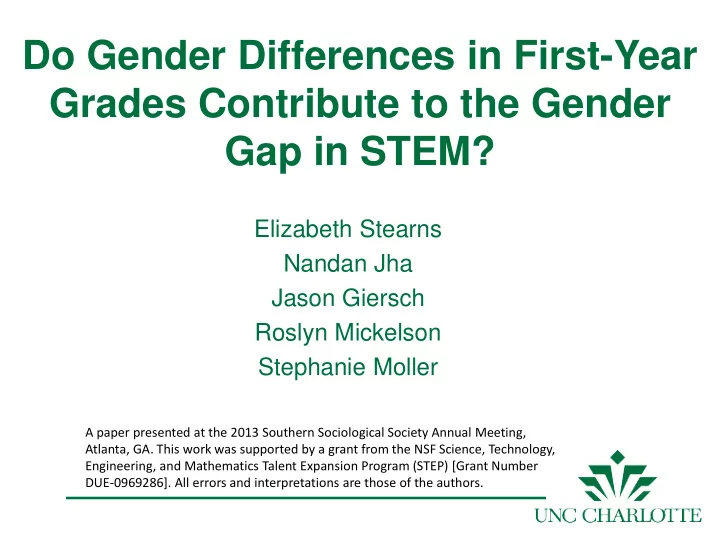

Do Gender Differences in First-Year Grades Contribute to the Gender Gap in STEM? Elizabeth Stearns Nandan Jha Jason Giersch Roslyn Mickelson Stephanie Moller A paper presented at the 2013 Southern Sociological Society Annual Meeting, Atlanta, GA. This work was supported by a grant from the NSF Science, Technology, Engineering, and Mathematics Talent Expansion Program (STEP) [Grant Number DUE-0969286]. All errors and interpretations are those of the authors.
Finding the Roots : Motivating Issues Continuing Underrepresentation of Women in STEM • Varied explanations One of the most common is academic • differences Riegle-Crumb et al. (2012) and others call into • question
Finding the Roots Individual Characteristics Grades 6-12 Post-Secondary Cultural, Social, Cultural, Social, and Structural and Structural Conditions Conditions Women’s and Men from Underrepresented Minority Groups’ Underrepresentation in STEM
Why Grades are Important • Rational choice/human capital perspective Grades as “signals” • Can push or pull students into or out of majors • Students choose major that will maximize later • returns
Gender and Grades • Young women earn higher grades Higher non-STEM grades may “pull” them toward • those fields Relative advantage in non-STEM • • Young women may also be more sensitive to grades than young men are Stereotype threat • • Do these gender differences in grades contribute to the gender gap in STEM?
Finding the Roots Data – North Carolina public high school students – Linked with data on public university students in NC First time in college freshmen who matriculated in fall 2004 N=21,339 – Multilevel models Students clustered within schools Glimmix procedure in SAS
The UNC Campuses
Outcome Variable • Multinomial logistic variable of major declaration • Student did not declare major • Student declared a non-STEM major • Student declared major in biological or agricultural sciences • Student declared major in physical sciences, engineering, or math
Measures of GPA • Two measures used in separate analyses Absolute GPA • Relative advantage of STEM grades (STEM GPA-non- • STEM GPA)
Controls School characteristics • Types of courses taken in HBCU • first year • Average SAT scores • Racial group of student • # of majors available Socioeconomic status • • High school • LEP • Location • First generation in college • % FRL College aspirations in 10 th • • % White grade M/S Focused School • • Extracurricular • School size participation in 10 th grade • Student/teacher ratio
Average First Year GPA by Gender and Types of Courses Type of Courses Young Men Young Women Average First Year GPA 2.416 2.670*** Average First Year GPA in STEM 2.188 2.347*** Courses Average First Year GPA in Non-STEM 2.540 2.830*** Courses Average of Comparative Advantage in -0.352 -0.483*** First Year GPA in STEM Courses v. Non- STEM Courses ***p<.001
Absolute GPA and PS/E Majors 0.14 Female, All Courses 0.12 Female, BIO & Non-STEM 0.1 Probability of Declaring PS/E Majors Female, PS/E & Non-STEM 0.08 0.06 Male, All Courses 0.04 Male, BIO & Non-STEM 0.02 Male, PS/E & Non-STEM 0 X̄ -2 σ X̄ - σ X̄ X̄ + σ X̄ +2 σ X̄ = Mean of GPA in First Year of College
Absolute GPA and Biology Majors 0.4 Female, All Courses 0.35 0.3 Female, BIO & Non-STEM Probability of Declaring BIO Majors 0.25 Female, PS/E & Non-STEM 0.2 0.15 Male, All Courses 0.1 Male, BIO & Non-STEM 0.05 0 X̄ -2 σ X̄ - σ X̄ X̄ + σ X̄ +2 σ Male, PS/E & Non-STEM X̄ = Mean of GPA in First Year of College
Relative GPA and PS/E Majors 0.18 0.16 Female, All Courses 0.14 Female, BIO & Non-STEM Probability of Declaring PS/E Majors 0.12 0.1 Female, PS/E & Non-STEM 0.08 Male, All Courses 0.06 0.04 Male, BIO & Non-STEM 0.02 Male, PS/E & Non-STEM 0 X̄ -2 σ X̄ - σ X̄ X̄ + σ X̄ +2 σ X̄ = Mean of Relative Advantage in First Year GPA in Science Courses
Relative GPA and Biology Majors 0.25 Female, All Courses 0.2 Probability of Declaring BIO Majors Female, BIO & Non-STEM 0.15 Female, PS/E & Non-STEM 0.1 Male, All Courses 0.05 Male, BIO & Non-STEM 0 Male, PS/E & Non-STEM X̄ -2 σ X̄ - σ X̄ X̄ + σ X̄ +2 σ X̄ = Mean of Relative Advantage in First Year GPA in Science Courses
Conclusions • Roots of STEM gender disparities do not lie in academic differences in performance during the first year of college Consistent with results regarding high school • performance • Explanations for this gender gap must look beyond the first year of college
Recommend
More recommend